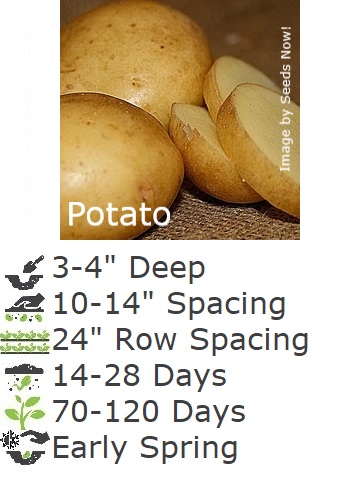
Overview
Potatoes are one of the most versatile vegetables on a Canadian Family’s Table. Hearty and frost resistant, with dozens of different varieties that grow in our Northern climate, you have plenty to choices. Nothing beats the taste and flavour of a garden-fresh potato.
Preparing Your Seeds
When preparing your seedlings, take care not to break off the sprouts, as this will delay the emergence of the vines. Not only that, but it will increase the number of vines that will emerge and will reduce the size of the potatoes you will harvest. Seedlings that are egg-size or smaller can be planted whole. When cutting up larger potatoes, be sure to leave at least two eyes and cut them into chunks of approximately 75 grams. You can trim and plant them immediately, or they may be allowed to heal over for a day. If you leave them for a day, DO NOT let them dry out and keep them out of direct sunlight as this will weaken them.
Soil Preparation
The ideal soil for a potato is deep, loose, and light. It should be well-drained but maintain a reasonable amount of moisture for the plant. Potatoes tend to be aggressive rooting plants and can take full advantage of such soil. The soil will have a direct impact on your harvest and can make for incredible yields. Fortunately, the potato is very adaptable and will produce quite well even in less than perfect conditions. Your goal should be a pH of 5.2-6.8, and soil with a high alkaline content tends to produce scabby potatoes. If using weak compost, be sure to supplement it with fertilizer, but not too much, as this will cause the plant to grow a lot of leaves but very few potatoes.
Planting
Potatoes planted 1-3″ below the surface can protect your seedling from even a hard freeze. Protect your plants if you get a late start in the season to protect them from prolonged cold and wet weather.
The optimal soil temperature for good growth ranges from 12-21 C. You can attempt to plant 6-8 weeks before the last frost if you can work the soil. Naturally, the spacing of your rows will depend on the size of your garden. However, you can get away with as little as 2′ between your rows.
Where you want your row, dig a shallow trench approximately 6-8″ deep and place your seedlings 10-14″ apart. Use a rake to cover the seedlings with 3-4″ of soil but DO NOT fill the trench.
Hilling
Sprouts will emerge in approximately two weeks, depending on your soil temperature. When the stems are about 8″ high, gently hill the stalk with soil scraped from both sides of the row. Be sure to leave half the stem exposed. Hilling puts the roots deeper and leaves the loose soil for the seedlings to form. You will repeat this process twice more at 2-3 weeks and once again two weeks after that. After the first hilling, the others will only require 1-2″ of additional soil. Be sure to keep all new forming potatoes covered so they won’t get exposed to the light.
Harvesting
Usually, within 7-8 Weeks of planting, most varieties are blossoming. At this time, early potatoes may be ready for harvest. Gently poke into the hill with making as little disturbance as possible to see what you find. Ideally, the best time to harvest is once the stalks have died, maximizing the size of your harvest. When removing the potatoes from the ground, be sure to let them sit in the garden for up to two weeks so that the skin hardens, making them more resistant to scuffing and bruising during storage.
Click Here to Return to the Main Page
